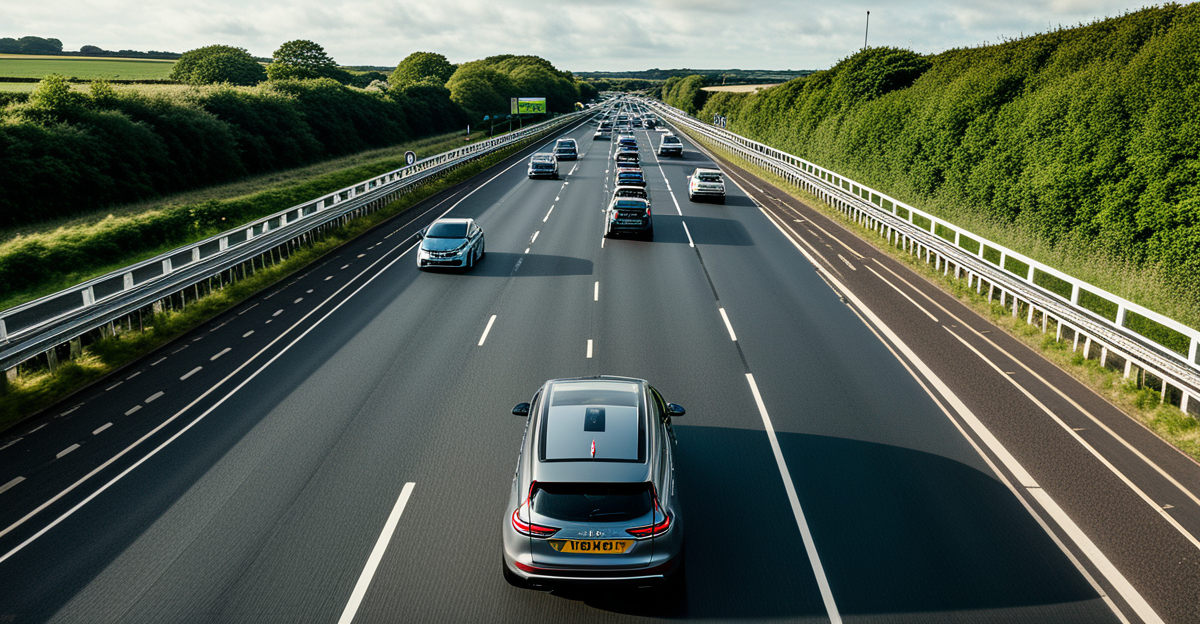Immediate Implications for UK Road Infrastructure
The rise of autonomous vehicles is triggering several immediate changes to the UK road infrastructure to ensure compatibility and safety. One of the foremost impacts involves modifications to current road layouts and markings. Traditional paint and signage must be adapted for enhanced machine readability, enabling vehicle sensors to accurately interpret lane boundaries, pedestrian crossings, and directional cues. This requires more precise and standardized markings, often incorporating reflective or sensor-friendly materials.
Integration of smart traffic signals and digital signage is also underway. These intelligent systems communicate in real time with autonomous vehicles, optimizing traffic flow and reducing waiting times at intersections. Early adopters are already seeing pilot implementations in select urban areas, where digital signs provide dynamic speed limits and caution alerts based on live data analysis.
Additional reading : Breaking Down Brexit: How Will It Affect the UK Car Industry?
Pilot cities like Milton Keynes are spearheading infrastructure upgrades on a small scale, testing new formats of interactive roadways equipped with sensor arrays embedded in the pavement. These changes are crucial for creating an environment where self-driving cars can navigate safely and efficiently. Collectively, these immediate impacts signal a transition phase focused on blending cutting-edge technology with established road networks, preparing the UK for a future where autonomous vehicles operate seamlessly alongside traditional traffic.
Upgrades and Investments Required for Self-Driving Vehicles
Deploying sensor technology and connectivity solutions is essential for the UK to support infrastructure upgrades compatible with autonomous vehicles. One core requirement involves the widespread implementation of vehicle-to-infrastructure (V2I) communication systems. V2I enables real-time data exchange between vehicles and road elements, improving safety and traffic efficiency. For example, roadside units equipped with dedicated short-range communication (DSRC) or 5G capabilities allow cars to receive timely updates on hazards or signal changes.
Also to discover : How Can Electric Vehicles Transform the British Automotive Industry’s Environmental Impact?
Alongside communication tech, road surfaces and markings must be enhanced for machine readability. This means using high-contrast, durable materials that maintain clarity even in adverse weather. Precise lane demarcations and tactile road features help sensors correctly interpret the environment. Such material upgrades are often necessary in conjunction with embedded sensors or reflective components to optimize autonomous vehicle perception.
Investment is pivotal to these upgrades. Funding often involves a blend of public and private contributions, reflecting the scale and complexity of adapting existing UK road infrastructure. Public investment ensures broad access and regulatory compliance, while private funding can accelerate innovation through pilot programs and technology development. Sophisticated cost-sharing models will be required to fund the ongoing maintenance and expansion of sensor networks and upgraded road materials. Overall, targeted investment aligned with technology deployment promises to drive the UK closer to a fully integrated autonomous vehicle ecosystem.
Government Policies and Planning Initiatives
The UK government policy on autonomous vehicle infrastructure is evolving to provide clear regulatory frameworks that support safe integration while fostering innovation. Current regulations emphasize rigorous safety standards for autonomous vehicles, including mandatory testing and compliance with vehicle-to-infrastructure communication protocols. These policies ensure that both hardware and software align with national safety objectives, minimizing risks as new technologies are deployed.
At the national and local levels, extensive infrastructure planning is underway to future-proof UK roads. This involves coordinating upgrades that consider both present vehicle technology and anticipated advances in automation. Strategic plans integrate enhancements such as sensor-enabled traffic management systems and smart road surfaces capable of interacting with vehicles. By focusing on interoperability across regions, the government aims to create a cohesive environment conducive to widespread autonomous vehicle usage.
Importantly, these initiatives align closely with broader transport strategies centered on decarbonisation. Policies encourage shifting towards sustainable modes of travel supported by autonomous technology, reducing emissions, and improving urban air quality. Integration of autonomous vehicles into the UK’s transport ecosystem is thus not solely a technological upgrade but part of a comprehensive plan addressing environmental and economic goals.
Together, the UK government’s regulatory frameworks and planning initiatives provide a robust foundation for adapting UK road infrastructure to the demands of self-driving cars. They balance innovation with safety and sustainability, ensuring that infrastructure developments are both forward-looking and practically implementable.
Challenges and Risks in Transitioning to Autonomous Vehicles
Transitioning the UK road infrastructure to accommodate autonomous vehicles presents significant infrastructure challenges that require careful management. One major challenge is the coexistence of autonomous and human-driven vehicles on the same roads. This mixed traffic environment complicates sensor interpretation and decision-making algorithms for self-driving cars, increasing the risk of miscommunications and potential accidents. Ensuring seamless interaction between these two vehicle types demands highly adaptive infrastructure and advanced vehicle programming.
Cybersecurity emerges as another critical concern in this transition. Autonomous vehicles rely heavily on connectivity for real-time data exchange via vehicle-to-infrastructure communication. This reliance opens vulnerabilities to malicious attacks or data breaches that could compromise both vehicle operation and public safety. Protecting communications and preserving data privacy necessitates robust encryption standards and continuous monitoring to guard against cyber threats targeting the autonomous ecosystem.
Emergency response preparedness also factors into infrastructure risks. A breakdown or accident involving an autonomous vehicle requires rapid and informed intervention from emergency services. UK emergency protocols must evolve to incorporate knowledge of autonomous systems, ensuring first responders can safely disable automated controls and access necessary vehicle data promptly. Additionally, infrastructure resilience must address system failures caused by extreme weather or technical faults, maintaining safety margins even in adverse conditions.
Managing these transition risks involves coordinated efforts between government agencies, technology developers, and road authorities. Developing scalable solutions to these challenges is essential to achieving a safe and reliable autonomous vehicle network within the UK.
Immediate Implications for UK Road Infrastructure
The immediate impact of autonomous vehicles on UK road infrastructure is evident in the required modifications to existing road layouts and markings. To support sensor compatibility, road surfaces need more precise, standardized markings. These often incorporate reflective materials or sensor-friendly compounds, ensuring autonomous vehicle cameras and lidar systems detect lane boundaries, pedestrian zones, and directional information accurately regardless of weather conditions.
Smart traffic signals and digital signage represent a major facet of this transformation. These systems enable real-time data exchange between road infrastructure and vehicles, optimizing traffic flow and safety. Smart signals adjust timings dynamically in response to traffic density, while digital signs deliver adaptive speed limits and hazard warnings directly to autonomous vehicles, enhancing situational awareness and reducing congestion.
Pilot cities such as Milton Keynes play a crucial role in testing these upgrades on a smaller scale. Sensor arrays embedded into road surfaces provide valuable data on vehicle movements and environmental conditions. These early-stage infrastructure updates serve as practical testbeds, allowing authorities to evaluate the effectiveness and reliability of technologies before wider nationwide deployment.
Together, these changes form the foundation for a road network that can accommodate the unique operational needs of autonomous vehicles, marking an essential step in the UK’s shift toward smarter, safer transport systems.
Immediate Implications for UK Road Infrastructure
The immediate impact of autonomous vehicles on UK road infrastructure centers on significant modifications to existing road layouts and markings. To enhance sensor compatibility, roads require more precise and standardized marking systems. These include using high-contrast, durable materials often embedded with reflective or sensor-friendly compounds. Such upgrades ensure that autonomous vehicles’ cameras and lidar systems accurately detect lane boundaries, pedestrian crossings, and direction indicators regardless of varying weather conditions and lighting.
A key area of transformation is the integration of smart traffic signals and digital signage. These systems facilitate real-time communication between road infrastructure and autonomous vehicles, allowing dynamic traffic management. Smart signals can adjust their timing in response to traffic flow, significantly reducing congestion and wait times. Digital signage complements this by providing adaptive speed limits and hazard warnings tailored to current road situations, directly informing vehicle decision-making and enhancing overall safety.
Pilot cities such as Milton Keynes are critical in implementing early-stage infrastructure updates. These urban testbeds use embedded sensor arrays within the road surfaces to collect data on vehicle movements and environmental factors, enabling authorities to assess and refine technology performance. Lessons from these pilot projects inform scalable solutions for nationwide infrastructure adaptation, providing practical insights into the challenges and benefits of integrating autonomous vehicles into the existing UK road network.
Collectively, these measures constitute immediate, foundational steps, preparing the UK’s road infrastructure to safely and efficiently support autonomous driving technology in the near future.






